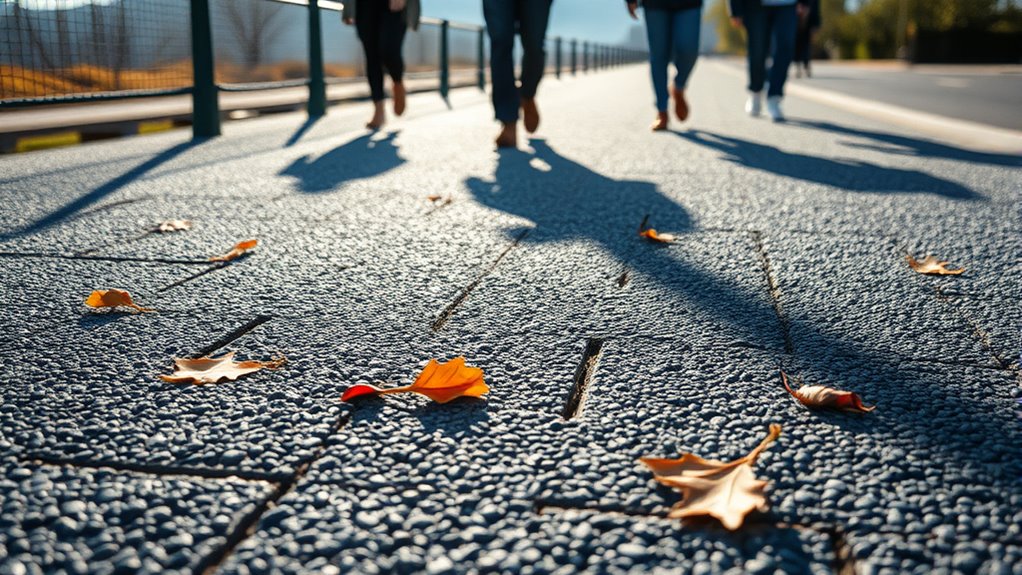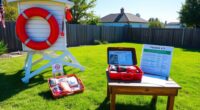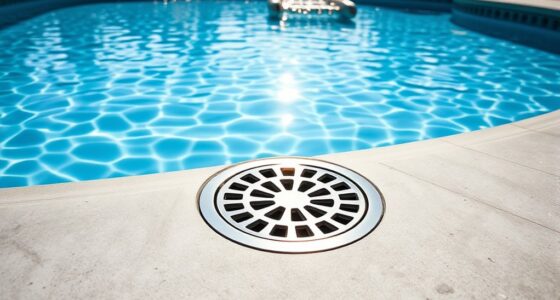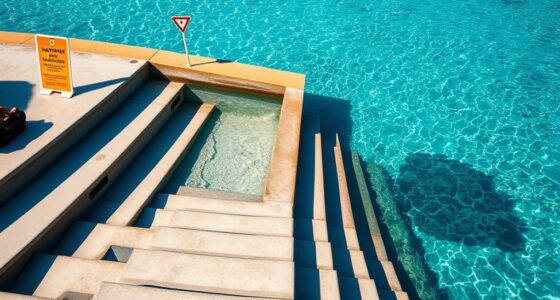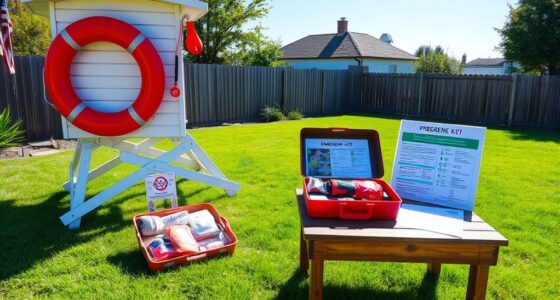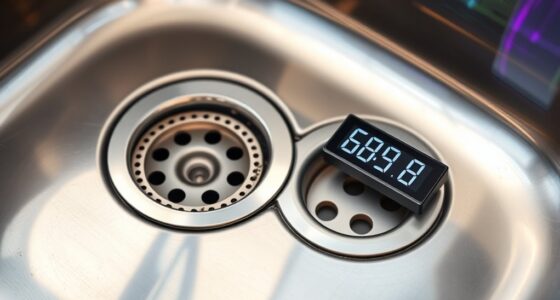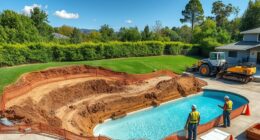To prevent slips and avoid costly lawsuits, consider installing non-slip surfaces like textured mats, coated floors, or slip-resistant tiles in high-risk areas. Using high-quality materials and textured designs enhances traction, reducing fall risks. Proper installation and regular maintenance are key to keeping surfaces effective and safe over time. Investing in these measures not only saves lives but also helps protect you legally. Keep exploring to discover how specific solutions can make a real difference.
Key Takeaways
- Installing high-quality, textured non-slip surfaces reduces fall risks and enhances safety compliance in various environments.
- Proper maintenance and timely repairs maintain slip resistance, preventing accidents and legal liabilities.
- Using coatings and textured materials creates durable friction, decreasing slip-and-fall incidents over time.
- Case studies show safety investments significantly lower injury rates and legal claims, saving costs.
- Proactive safety measures protect lives, minimize negligence risks, and support legal defenses against slip-related lawsuits.
Understanding the Risks of Slippery Surfaces

Slippery surfaces pose significant safety hazards that can lead to falls and injuries. When you walk on wet, oily, or icy floors, your footing becomes unstable, increasing the risk of slipping. These hazards are common in places like kitchens, bathrooms, outdoor walkways, and commercial areas. The danger intensifies when footwear doesn’t provide enough traction, or the surface isn’t designed to grip under different conditions. Falls caused by slippery surfaces can result in fractured bones, sprains, or head injuries, sometimes with long-lasting effects. Recognizing these risks helps you stay alert and cautious. Regular maintenance, prompt spill cleanup, and understanding where hazards exist are vital steps to prevent accidents and keep everyone safe.
Types of Non-Slip Surfaces and Materials
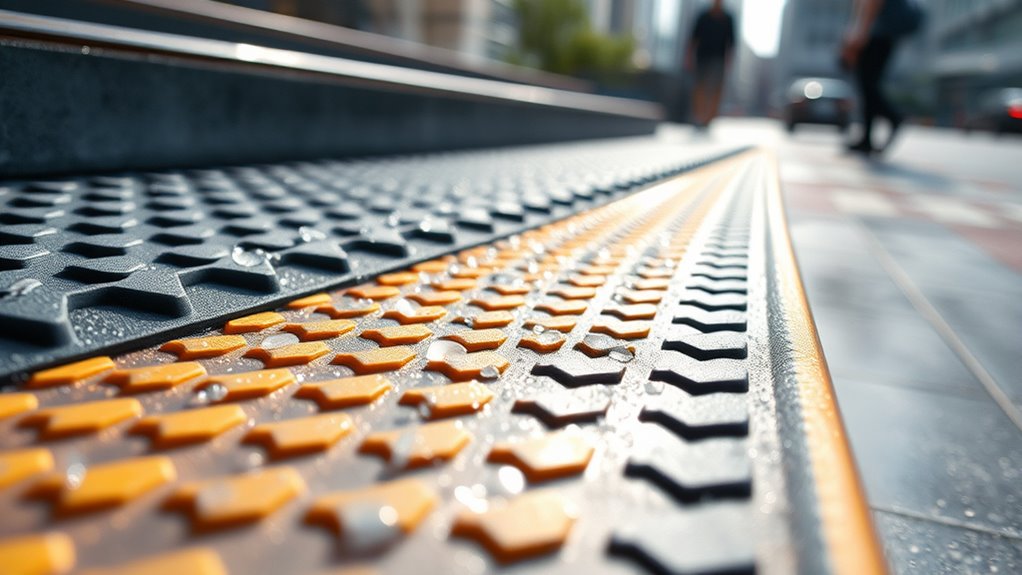
Have you ever wondered what materials can help prevent slips and falls? There are several effective options to contemplate. Textured rubber mats and coatings provide excellent grip, especially in wet areas. Gritted concrete or epoxy floors with embedded aggregates create slip-resistant surfaces on walkways and stairs. Ceramic tiles with textured surfaces or slip-resistant finishes are common in bathrooms and kitchens. Anti-slip tapes and adhesives are versatile and easy to apply on stairs, ramps, or outdoor pathways. Additionally, vinyl flooring with textured patterns offers good traction in commercial and residential settings. Each material is designed to enhance grip and reduce accidents. Choosing the right type depends on your environment, foot traffic, and specific safety needs. Regular use of non-slip surfaces can significantly reduce the risk of slips and falls, helping to prevent injuries and potential lawsuits.
How Non-Slip Coatings Enhance Safety

Non-slip coatings improve safety by providing better traction and grip, reducing the risk of slips and falls. They act as a reliable safety barrier that stays effective over time, even in challenging conditions. With these coatings, you can create safer surfaces that keep everyone protected. Additionally, selecting the right juice cleanse can support overall wellness and hydration, contributing to a healthier environment for everyone.
Enhanced Traction and Grip
Because non-slip coatings are designed to increase friction, they markedly improve traction and grip on surfaces. When you apply these coatings, you reduce the risk of slips, trips, and falls, especially in wet or oily conditions. Enhanced grip means your footwear or tires maintain better contact with the surface, giving you greater control and stability. This is particularly vital in workplaces, kitchens, hospitals, or outdoor areas where slick surfaces are common. Non-slip coatings create a textured surface that resists slipping even when moisture or contaminants are present. As a result, you can move confidently without fear of losing footing. Improved traction not only protects you but also minimizes liability risks for property owners and employers, making environments safer for everyone. Additionally, choosing appropriate surface treatments can extend the lifespan of flooring and reduce maintenance costs over time.
Long-Lasting Safety Barrier
Non-slip coatings serve as a durable safety barrier that extends their protective qualities over time, even with frequent use. They resist wear, maintain traction, and prevent slips in high-traffic areas. To maximize their longevity, consider these key factors:
- Proper surface preparation ensures adherence and durability.
- Regular inspections identify signs of wear or damage early.
- Reapplication or touch-ups restore slip resistance when needed.
- Selecting high-quality coatings tailored to specific environments prolongs effectiveness.
The Role of Textured Surfaces in Preventing Falls

Have you ever wondered how simple surface textures can make a big difference in preventing slips and falls? Textured surfaces increase traction by creating friction between your shoes and the walking surface. When surfaces are rougher or patterned, they help channel away liquids like water or oil, reducing slipperiness. This is especially important in high-traffic areas such as entryways, commercial kitchens, or outdoor walkways. By intentionally designing surfaces with grooves, ridges, or patterns, you provide better grip even when surfaces are wet or oily. The increased friction helps you maintain balance and stability, decreasing the risk of accidents. Incorporating natural materials like wood or stone in textured surfaces can further enhance safety and aesthetic appeal. Textured surfaces are a simple yet effective way to enhance safety without needing complex systems, making them a practical choice for many environments.
Installation and Maintenance of Non-Slip Solutions
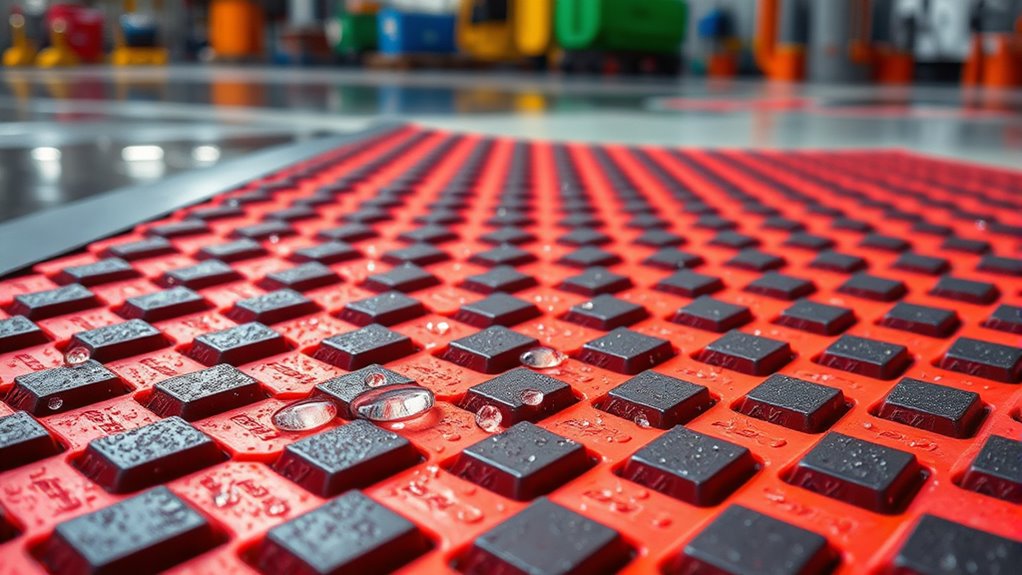
To guarantee your non-slip surfaces work effectively, you need to follow proper installation techniques from the start. Regular maintenance is essential to keep the surfaces safe and functional over time. By staying attentive to these practices, you’ll prevent accidents and extend the lifespan of your non-slip solutions. Regular inspections and cleaning of the surface ensure optimal performance and safety, especially when combined with appropriate surface preparation and protective finishes.
Proper Installation Techniques
Proper installation is essential to guarantee your non-slip surfaces perform effectively and remain durable over time. If you don’t follow precise techniques, the surface may fail, leading to accidents and liability. To assure a proper installation:
- Clean the substrate thoroughly to remove dirt, grease, and old coatings.
- Follow manufacturer instructions precisely, including mixing ratios and curing times.
- Apply the slip-resistant coating evenly using appropriate tools for consistent coverage.
- Allow sufficient drying and curing time before subjecting the surface to foot traffic.
- Incorporate proper ventilation considerations to ensure safe curing and avoid moisture buildup.
Skimping on preparation or rushing the process can compromise adhesion and performance. Paying close attention to these steps ensures your non-slip solution provides lasting safety, minimizing risks and potential legal issues.
Routine Maintenance Practices
Are you ensuring your non-slip surfaces stay effective over time? Regular maintenance is key to lasting safety. Inspect the surfaces frequently for wear, damage, or debris that could compromise their grip. Clean them thoroughly using appropriate methods—avoid harsh chemicals that might degrade the material. Reapply anti-slip coatings or treatments as recommended by the manufacturer to maintain traction. Address any cracks, chips, or worn areas promptly to prevent accidents. Keep drainage clear to avoid water pooling, which can increase slip risks. Educate staff or visitors to report hazards immediately. Consistent upkeep guarantees your non-slip surfaces continue to perform as intended, reducing liability and saving lives. Effective routine maintenance is your best defense against slips and falls.
Legal Implications of Slip-and-Fall Incidents
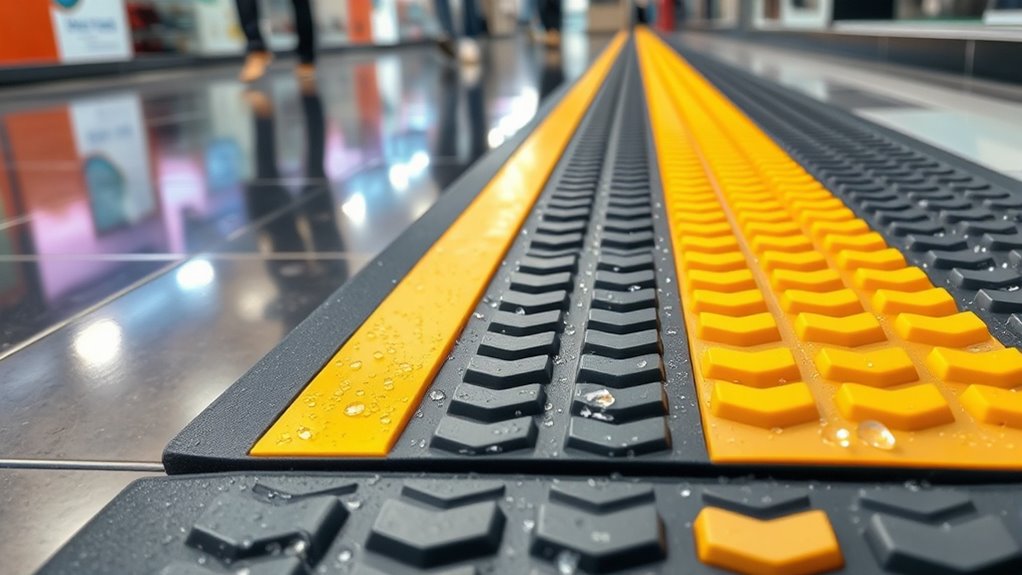
Slip-and-fall incidents on non-slip surfaces can lead to serious legal consequences for property owners and managers. If someone gets injured due to hazardous conditions, you could face costly lawsuits and reputational damage. To mitigate these risks, it’s essential to understand the legal standards and responsibilities involved.
Consider these key points:
- Duty of Care: You’re legally required to maintain safe premises and address known hazards promptly.
- Negligence: Failing to repair or warn about dangerous conditions can be seen as negligence, increasing liability.
- Evidence Gathering: Proper documentation of maintenance and safety measures can protect you in court.
- Legal Precedents: Past rulings often emphasize proactive safety measures, making non-slip surfaces vital for compliance.
- Proper Equipment: Using high-quality slip-resistant materials can significantly reduce the risk of accidents and legal exposure.
Staying ahead legally involves proactive safety investments and diligent maintenance.
Cost-Benefit Analysis of Investing in Non-Slip Surfaces
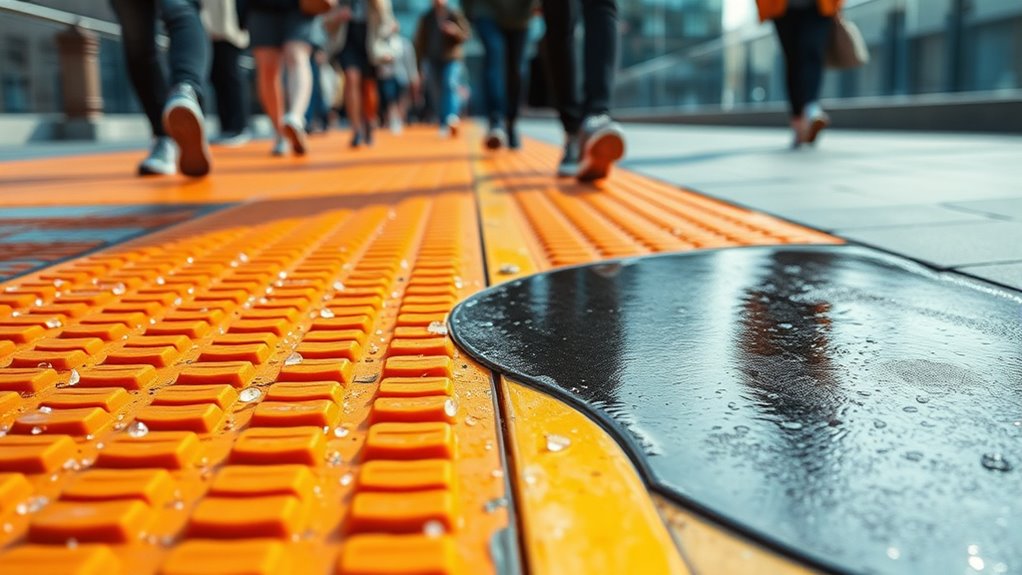
Investing in non-slip surfaces can substantially reduce the risk of accidents and the costly legal liabilities that come with slip-and-fall injuries. While initial installation costs vary, they are often outweighed by the long-term savings from fewer accidents and insurance claims. Non-slip surfaces decrease injury rates, which means fewer compensation payouts and lower insurance premiums. Additionally, businesses benefit from improved reputation and customer trust, reducing potential lawsuits. The upfront investment might seem significant, but when you consider the costs associated with injury claims, legal fees, and downtime, the value becomes clear. Proper surface design can further enhance safety and effectiveness. In the end, the financial benefits of investing in non-slip surfaces often outweigh the expenses, making it a smart, proactive approach to safety and liability management.
Case Studies Showcasing the Impact of Non-Slip Measures

Have businesses truly benefited from implementing non-slip measures? Absolutely. Case studies reveal significant reductions in slip-and-fall incidents, saving costs and protecting reputations. For instance:
Implementing non-slip measures significantly reduces accidents, saving costs and protecting your business reputation.
- A manufacturing plant reduced employee injuries by 60% after installing slip-resistant flooring.
- A shopping mall cut liability claims by 40% following the application of anti-slip coatings.
- A hospital minimized legal actions related to falls by 30% after upgrading bathroom surfaces.
- A restaurant chain saw insurance premiums drop as safety measures decreased accident rates.
These real-world examples demonstrate that non-slip surfaces not only enhance safety but also deliver tangible financial benefits. By analyzing these case studies, you can see the profound impact that strategic non-slip measures have on reducing risks and safeguarding your business.
Frequently Asked Questions
How Long Do Non-Slip Coatings Typically Last Before Reapplication Is Needed?
Non-slip coatings usually last between one to three years before needing reapplication. Factors like foot traffic, weather conditions, and surface wear can influence their durability. You should inspect the coating regularly for signs of wear or smoothness, especially in high-traffic or outdoor areas. Reapplying when the coating starts to degrade helps maintain safety and compliance, preventing slips and potential lawsuits. Regular maintenance ensures your surfaces stay slip-resistant longer.
Are Non-Slip Surfaces Suitable for Outdoor Environments Exposed to Weather?
Yes, non-slip surfaces are suitable for outdoor environments exposed to weather. They’re designed to withstand elements like rain, snow, and UV rays, providing reliable traction year-round. You should choose coatings specifically formulated for outdoor use, as they resist fading and wear better than indoor options. Regular maintenance and inspections help guarantee the non-slip properties stay effective, keeping you safe even in harsh weather conditions.
What Are the Environmental Impacts of Different Non-Slip Materials?
You’ll find that non-slip materials vary in environmental impact. Rubber and recycled rubber are eco-friendly options, reducing waste and providing durability. Polyurethane coatings offer good traction but may contain chemicals that could leach into the environment. Textured concrete is durable with minimal chemical use, yet it requires significant energy to produce. Choosing sustainably sourced or recycled materials can minimize ecological footprints while maintaining safety and longevity.
Can Non-Slip Surfaces Be Customized for Aesthetic Preferences?
Like an artist with a blank canvas, you can customize non-slip surfaces to match your aesthetic preferences. You choose colors, patterns, and textures, making safety seamlessly blend with design. Many materials, such as epoxy coatings and textured vinyl, offer versatile options. This way, you enhance safety without sacrificing style, ensuring your space remains both beautiful and secure, just like a well-crafted masterpiece that’s both functional and visually appealing.
How Do Non-Slip Solutions Perform in Areas With Heavy Foot Traffic?
Non-slip solutions perform exceptionally well in areas with heavy foot traffic because they provide reliable traction under various conditions. You’ll notice improved safety as these surfaces reduce the risk of slips and falls, even when wet or oily. They’re durable, able to withstand constant use without wearing down quickly. By installing non-slip surfaces, you protect visitors and your property, creating a safer environment that minimizes accidents and potential legal liabilities.
Conclusion
By investing in non-slip surfaces, you’re not just preventing falls—you’re building a safety net that catches lives and shields you from costly lawsuits. Imagine walking on a smooth, icy sidewalk only to slip and fall; now picture that same stretch treated with textured, non-slip material. The difference is like night and day. Taking proactive steps today guarantees your space remains a secure haven, turning potential hazards into safe pathways.
